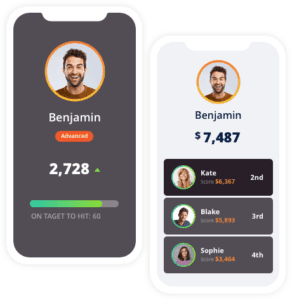In this post, we’re going to show you how to monitor sales team performance with a dashboard tool. Sales are all about performance.
At the end of the day, you’re only meeting your target for the quarter because your reps put in the work. All that effort compounds to create the results you’ve set out to achieve.
However, in order to create a structured performance monitoring process, you’re going to need a little help from tech.
Sales Dashboards: Monitoring More than Sales Funnels
While sales dashboards originally started out as tools allowing C-level executives to monitor their results and the efficiency of their sales funnels, they’ve transformed into versatile tools.
Today’s sales dashboards not only show you funnels (and leakages), but they also help your team reach their goals through data-driven decisions.
This is all possible because of a holistic perspective:
You can use your sales dashboards to completely understand your sales performance while monitoring the most important factor of them all: your reps.
A good sales dashboard will be able to provide you with:
- Bird’s-eye view of your sales performance
- The micro view highlighting the effort and actions your sales reps put in.
The key to using sales dashboards to monitor your team performance is data.
Ideally, your sales dashboard will be pulling data from all the tools your reps use.
It has to be integrated with your CRM software in order to give you the best understanding of what makes your sales process (and your reps) tick.
Ultimately, your sales dashboard should allow you to understand your sales process as a whole and identify all the micro-moments and activities your sales reps take in order to meet the quota.
The trick is in setting it up.
How to Monitor Sales Team Performance with a Sales Dashboard
There are a few ingredients that will go into your sales dashboard formula:
- Goals and KPIs
Before you start tweaking your sales dashboard to fit your team performance monitoring needs, you have to understand your goals:
- Do you want to understand which rep behaviors drive the most success?
- Do you want to improve individual rep performance on your team?
- Do you want to strengthen teamwork and/or competition?
- Do you want to optimize your sales process, fix funnel leakages, etc.?
- Do you want to improve sales-marketing collaboration?
There are a lot of reasons why you might need to monitor sales performance, but it’s important that you’ve clearly outlined them.
The more specific your goals are, the better will you be able to set up your dashboard. Make sure you have an even balance between short and long-term goals. Short-term goals will motivate your reps to achieve the long term ones.
You can even ask your sales team to help you define goals.
This way, you’ll know if there are any potential obstacles, and if your reps need additional tools and guidance. Participating in the process will ensure that your dashboard adoption rates are high enough.
Then, it’s time to define your KPIs.
Again, the majority of sales managers use general metrics like quotas, targets, revenue, won/lost rates, and so on.
However, when it comes to monitoring team performance, you’re going to need to dig deeper:
- Selling time
- Emails and calls
- Opportunity win rate
- Cost to revenue ratio
- Deals closed
You want to have a good balance between activity-based metrics that show you what kind of actions your reps are performing, and results-oriented metrics that demonstrate the direct influence of activities on your bottom line.
It’s the best way to optimize your sales process.
- Data is key
Without data, all of this falls through.
The data you’ll need depends on your goals.
For example, if you want to improve your overall sales process company-wide, you’ll need access to C-level data, as well as activity data from your sales reps.
However, if you just want to improve the performance of your reps, you’ll likely get everything you need from a CRM tool.
Some of the tools to gather data might include:
- BI
- CRM
- Sales
- Customer service software
Your sales dashboard should have all the necessary integrations.
If you’re using highly-specific software for some functionalities, discuss the integration options with your sales dashboard provider.
The data should pour into your dashboard in real-time, as that’s the best way to keep a constant eye on progress.
- Choosing a sales dashboard
Your sales dashboard should provide data and allow you to gauge clear insights at a glance.
You want to review your sales process from a birds eye’s view. On the other hand, you need to be able to go into the details and specifics of what your team is doing.
When you have both, you’ll know how to shape your strategy.
However, if you want to use your sales dashboard to its full capacity, you have to improve user adoption.
And that’s where Spinify comes in!
As a sales dashboard created to improve user adoption and motivate your sales reps, it’s a great solution for monitoring team performance.
With Spinify, you’ll have access to a variety of useful features:
- Gamification: points, achievements, rewards, and tiers
- Contests and challenges
- Leaderboards and healthy competition
- Performance tracking
- Individual coaching insights
- Availability: desktop, mobile, and office TVs
These features will ensure that your reps are motivated to use your sales dashboard, and monitor their progress on it.
Consequently, the data will be more reliable.
Spinify is made for top-performers and steady reps
You’ll be able to track all the metrics that matter to you, all the while motivating your reps to perform to the best of their capabilities.
Every rep will get points for performing actions that bring them closer to goals, and you’ll know exactly who needs guidance.
Everything is transparent; you’ll be able to coach reps who need you the most without having to spend hours gauging insights from data pools.
Ultimately, when you sign up for Spinify, you’ll have a solution you can rely on.
Our customers report a 54% uplift in monthly calls, a 40% increase in activities completed and a 66% uplift in monthly net profits.




